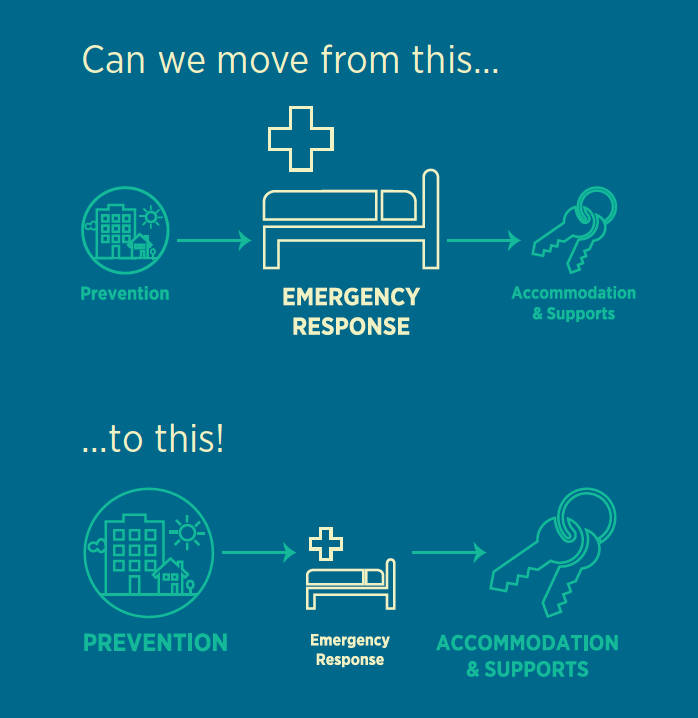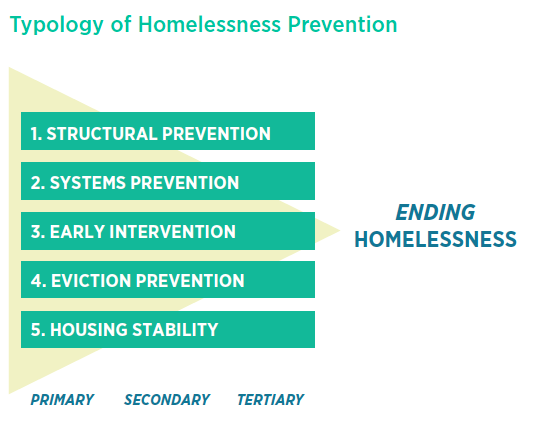There are three main ways you can address homelessness:
- Prevention – Stopping people from becoming homeless in the first place.
- Emergency Response – Providing emergency supports like shelter, food and day programs, while someone is homeless.
- Housing, Accommodation, and Supports – The provision of housing and ongoing supports as a means of moving people out of homelessness.

Since mass homelessness emerged in the mid-1980s, we have largely used emergency services to respond to people’s immediate needs. While we will always need emergency services to help those in crisis, over time these short-term responses have become the standard method for managing homelessness long-term.
In the last decade, Canadian policies and practices have begun to shift from managing homelessness to finding solutions, in particular the expansion of the Housing First approach across the country. The Housing First model provides housing and supports for people experiencing chronic homelessness with no housing readiness requirements. New research, innovation, and best practices have propelled our thinking to make the goal of ending homelessness realistic; however, we are still missing an important piece – preventing homelessness in the first place.
Why must we wait until people are entrenched in homelessness before offering help?
The international evidence reveals that homelessness prevention makes sense from social and economic perspectives. See research from:
Evaluations of prevention initiatives in Germany, England, and the UK demonstrated that prevention contributed to the reduction of homelessness. A range of prevention interventions, from evictions prevention, support for survivors of intimate partner violence, to landlord mediation, all showed success.
In Canada, research on the importance of discharge planning from correctional facilities, hospitals, and shelters provides evidence that prevention efforts can and will be successful in the Canadian context. Research continues to inform emerging practices to support key populations including, youth, veterans, families, and those with high-needs such as addictions and/or mental health challenges. While there continue to be gaps in the knowledge on homelessness prevention, particularly as it relates to evaluation and measuring outcomes, the evidence is mounting that it is effective and worth investing in.
|
Definition of the Prevention of Homelessness Homelessness prevention refers to policies, practices, and interventions that reduce the likelihood that someone will experience homelessness. It also means providing those who have been homeless with the necessary resources and supports to stabilize their housing, enhance integration and social inclusion, and ultimately reduce the risk of the recurrence of homelessness. The causes of homelessness include individual and relational factors, broader population-based structural factors, and the failure of many public institutions to protect people from homelessness. This suggests that homelessness prevention must not only include interventions targeted at individuals, but broader structural reforms directed at addressing the drivers of homelessness. That not only communities but all orders of government, and most departments within have a responsibility to contribute to the prevention of homelessness is in keeping with a human rights perspective. |
Adapting the public health model
Homelessness prevention adapts the public health model of prevention, which has been used since the 1940s to reduce the risk and harms associated with illnesses. The public health model provides a range of prevention interventions that should take place simultaneously.
Primary prevention
Refers to structural-level initiatives that apply to everyone, in order to reduce the risk of homelessness and build protective factors. From a health perspective, primary prevention includes immunization programs or anti-smoking campaigns. The framework breaks down primary prevention further to describe an array of strategies that impact the population at large:
- Universal prevention – policies and interventions that target the broad public. While these strategies do not always have homelessness prevention as their goal, they have the effect of reducing the risks of becoming homeless by creating greater equality, which is vital to homelessness prevention. Examples include having an adequate supply of affordable housing and poverty reduction strategies, such as greater access to affordable child care.
- Selected prevention – prevention efforts aimed at members of a particular group, such as school-based programs and anti-oppression strategies for individuals facing discrimination, in particular Indigenous Peoples. It also includes programs aimed at low-income people, such as the basic income program currently being piloted in Ontario.
- Indicated prevention – applies to all those who are disadvantaged to ensure they do not become homeless in the first place. Examples of indicated prevention include support for families experiencing violence and individuals facing mental health and addictions challenges.
Secondary prevention
Those intervention strategies aimed at those who are at imminent risk of homelessness (i.e. received an eviction notice) as well as those who have recently become homeless, with the aim of avoiding homelessness or moving out of homelessness as quickly as possible. Secondary prevention includes a range of options from emergency financial assistance, family mediation, and domestic violence victim support, to name a few.
Tertiary prevention
Prevention initiatives that support individuals and families who have previously experienced homelessness to ensure that it doesn’t happen again. The Housing First model is a type of tertiary prevention by providing chronically homeless individuals with housing and supports to maintain housing stability.
These classifications exist along a continuum. In order to effectively prevent homelessness, all three forms of prevention must occur simultaneously. Most of the prevention programs that exist in Canada and internationally fall into the secondary prevention category. While these interventions are crucial to support those in crisis, secondary interventions alone cannot prevent homelessness. Structural and systemic interventions that work at the level of primary prevention are needed to provide the policy, practice, and funding backbone for individual interventions to be successful.
Typology
The typology described below outlines the various policies, practices, and interventions needed to prevent homelessness in Canada. Prevention requires an integrated systems approach, where each category works in union with one another. Moreover, each of the five categories has implications for primary, secondary, and tertiary prevention. As described above, the classifications are not discreet; homelessness prevention requires an increased level of coordination between all levels of government, collaboration between systems and institutions, and cooperation at the community level. The typology is as follows:

Structural prevention
Legislation, policy, and investment that builds assets, and increases social inclusion and equality.
- Examples: Increase the affordable housing stock, anti-discrimination policy, practice, and training, poverty reduction strategies, and income supports
Systems prevention
Addressing institutional and systems failures that contribute to the risk of homelessness.
- Examples: Barriers to accessing supports, such as transportation challenges, disability, linguistic barriers, cost, citizenship requirements, difficulty with system navigation, etc.
Early intervention
Policies and practices to support individuals and families at imminent risk of homelessness or who have recently become homeless.
- Examples: Family mediation, shelter diversion, case management
Evictions prevention
Programs and strategies designed to keep people at risk of eviction in their home and avoid homelessness.
- Examples: Landlord/tenant legislation, rent supplements, emergency funds, legal advice and representation
Housing stability
Initiatives and support for people who have experienced homelessness that allows them to exit homelessness quickly and never experience it again.
- Examples: Housing First, help obtaining and retaining housing, supports for health and well-being, education and employment, and enhancing social inclusion
